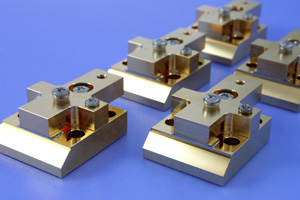- News
1 June 2015
FBH reports record 2kW output from single 1cm-long diode laser bar
In a talk and a tutorial at CLEO 2015 (Conference on Lasers and Electro-Optics) in San Jose, CA, USA (10-15 May), a team led by Paul Crump from FBH (Ferdinand-Braun-Institut, Leibniz-Institut fur Hoechstfrequenztechnik) of Berlin, Germany presented the latest results from the project CryoLaser (which ran from January 2012 to December 2014), demonstrating for the first time that a single 1cm laser bar can deliver at least 2kW of optical output power, when cooled to 203K.
Ultra-high-energy lasers are tools for basic science, for novel medical applications and, not least, for laser-induced fusion. The systems require diode lasers that are not just extremely capable, but also manufacturable at low costs in very high volumes. Specifically, diode lasers bars in the wavelength range 930-970nm are the fundamental building blocks for pump sources for ytterbium-doped crystals in large laser facilities, where optical pulses are generated with petawatt-class peak energies and picosecond pulse widths. The individual laser bars in these pump sources have a typical output power of 300-500W.
FBH is currently optimizing both the necessary design and technology as a part of the project CryoLaser, which is funded by Germany's Leibniz Association. If the cost per photon is to fall, a higher optical power density must be generated, reducing the amount of material needed. The conversion efficiency must also be dramatically improved for enhanced system efficiency. CryoLaser uses a novel design concept, developing innovative structures that are optimized for operation far below the freezing point (-70°C, 203K), since the performance of diode lasers is substantially improved at such temperatures.
 Picture: Laser bars with optimized mounting for high-power operation on CCP mount, developed within the CryoLaser project (photo: FBH/P. Immerz).
Picture: Laser bars with optimized mounting for high-power operation on CCP mount, developed within the CryoLaser project (photo: FBH/P. Immerz).
Building on advances in epitaxial design and packaging technology, FBH bars emitting at a wavelength of around 940nm at temperatures of -70°C (203K) delivered what is reckoned to be a record 2kW peak power per bar at a current of 2kA, a pulse width of 200µs and 10Hz repetition rate (corresponding to a pulse energy of 0.4J). Peak power was limited by the available current. To date, such powers could only be achieved by combining the optical beams from at least four single bars. The electro-optical energy conversion efficiency was 65% at 1kW output and 56% at 2kW. Such bars have the potential to play an important role in future high-energy-class laser facilities, says FBH. Currently, the team is working to further increase the conversion efficiency of the laser bars.
The FBH is responsible for the full value chain within the CryoLaser development project, from design to construction of first prototypes. The final pump sources are being evaluated for potential use in high-energy-class diode-pumped solid-state laser systems together with various groups in the field - LIFE in the USA and HiPER (European High Power laser Energy Research) in the EU. Project partners include the USA's Lawrence Livermore National Laboratory and the Central Laser Facility (CLF) at the UK Science and Technology Facilities Council (STFC) Rutherford Appleton Laboratory.
www.fbh-berlin.com/business-areas/diode-lasers/


